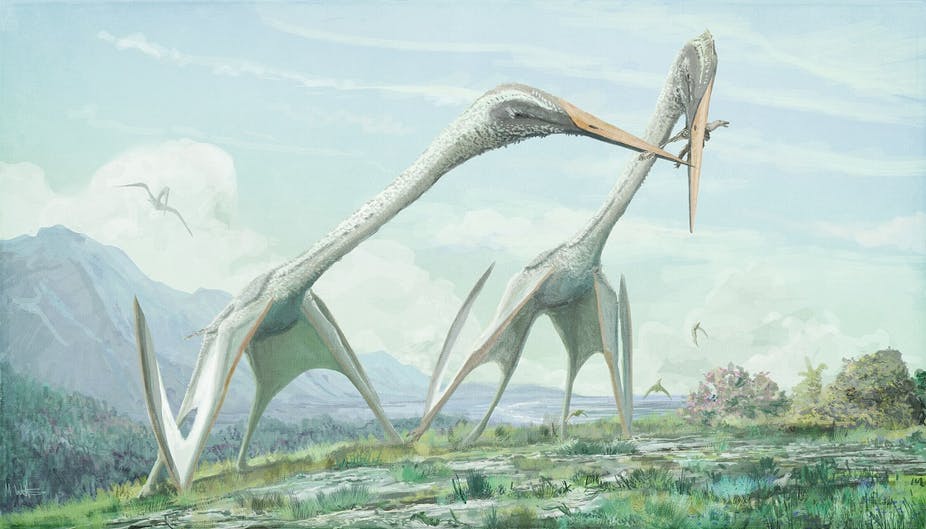
Pterosaurs were the very first vertebrates to evolve powered flight nearly 230 million years ago. Previously, only insects were capable of flying. However, the origin of pterosaurs has always been wrapped in mystery since no major relative had been identified — until now.
In a new study published today in the journal Nature, paleontologists at Virginia Tech have described a group of “dinosaur precursors”, known as lagerpetids. According to the researchers, these are the closest relatives of pterosaurs, filling a gap in their evolutionary history that had been eluding scientists for the past 200 years.
“‘Where do pterosaurs come from and how did they gain flight?’ is one of those ‘big’ questions that we know little about largely because pterosaurs appear in the fossil record in nearly their full form. We have known for decades that pterosaurs are dinosaur cousins, but there was little to fill in the gap between the two until recently – enter lagerptids,” Sterling Nesbitt, professor of geobiology at Department of Geosciences in the College of Science at Virginia Tech and co-author of the new study, told ZME Science.

The study is the culmination of 15 years of work by five research groups across six different countries and three continents — and it all came together thanks to the braincase of a lagerpetid, known as Dromomeron gregorii, which had been gathering dust in a drawer in the fossils collections of the University of Texas at Austin.
“The fossil was found in the late 1930s or early 1940s, and was sitting in the collection untouched until I recognized its potential for understanding lagerpetid skull structures. It was thrilling to find the partial skull,” Nesbitt said.
“Anytime we find out something new about a fossil is incredibly exciting. It’s even better when it’s something that was there all along. The Dromomeron fossils were collected by people in the Works Progress Administration nearly 80 years ago, so they weren’t scientists that were doing that work. They did an amazing job carefully collecting these tiny fossils, and they ended up being key for our study. Museum collections are vital for preserving specimens until all the right pieces come together to interpret them in a new way,” Michelle Stocker, assistant professor of geobiology at Virginia Tech and co-author of the study, told ZME Science.
Further investigation of the braincase showed that these reptiles had a fairly good sense of balance and were likely agile animals. Other numerous lagerpetid partial skeletons from the United States, Brazil, Argentina, and Madagascar filled in critical gaps in the fossil records.
These fossils gave paleontologists confidence in their assessments of lagerpetids: small, wingless reptiles that lived across the supercontinent of Pangea during the Triassic, from 237 to 210 million years ago.

“The fossils of lagerpetids and early pterosaurs are spread across the world (when they lived, the world was connected into Pangea) so it took time to see many of the fossils. One of the best aspects of this project was working with such an amazing group of scientists around the world – we came together to solve a long-standing problem,” Nesbitt said.
In order to reconstruct the brains and sensory systems of the lagerpetids, the researchers used micro-computed tomographic (μCT) scanning on the skulls included in the study. This technology enabled the team to generate 3-D models of the brain and inner ear anatomy of these tiny, fragile fossils without having to make any cuts.
“We were able to make a lot of our interpretations because of the application of CT technology to look at the inner portions of these fossils in a non-destructive manner. Features of the brain and inner ear wouldn’t have been possible to see without either this technology or destroying the specimen to get the data, so this has been a groundbreaking way to ‘see inside’ delicate fossils,” Stocker said.
Strikingly, the researchers found that the lagerpetids had already evolved some of the neuroanatomical features that allowed the pterosaurs to fly. According to Nesbitt, pterosaurs and lagerpetids share numerous characteristics across their skeletons, especially in the jaws, teeth, and braincase.
Paleontologists used to think that pterosaurs are an example of accelerated evolution judging from their unique body plan. But the lagerpetids fossils show that pterosaurs weren’t special — we were just missing some important puzzle pieces.

Some questions still remain, though. Chief among them is where are the lagerpetids wings? Perhaps they were only one or two steps away — only the discovery of new transitional fossils may help shed more light.
“Pterosaurs are fascinating because they are the first group of vertebrates to achieve flight. How and when they did that has always been a mystery, and it’s something that required both existing fossils in museum collections and fieldwork to find new fossils in order to finally decipher that story,” Stocker said.
“Our research group is focused on the animals and ecosystems in the Triassic Period, and we’re so excited to get back out in the field and travel to museums as soon as is safe. Understanding the early evolution of pterosaurs is just one of the many exciting projects our students are pursuing in the Triassic. It’s important for both our students and the public to understand how important paleontology is for understanding and appreciating life on our planet, and also to understand how vital museums and museum collections are for facilitating that understanding. We should all take care of these representations of our shared evolutionary history,” she added.
“We will keep unlocking the mysteries of the origin of dinosaurs, pterosaurs, and crocodile-like animals, particularly in the Triassic Period,” Nesbitt said.


